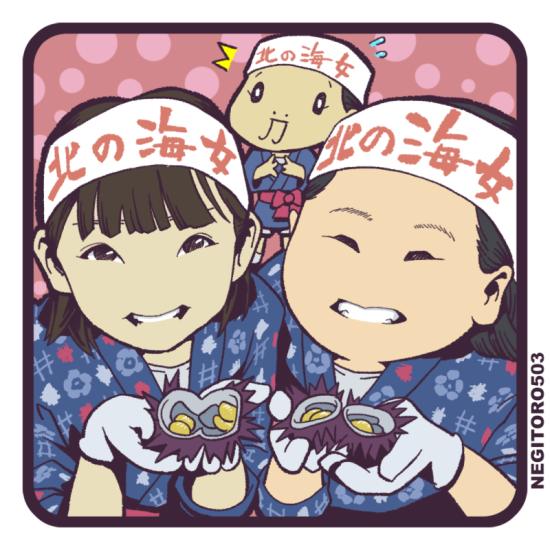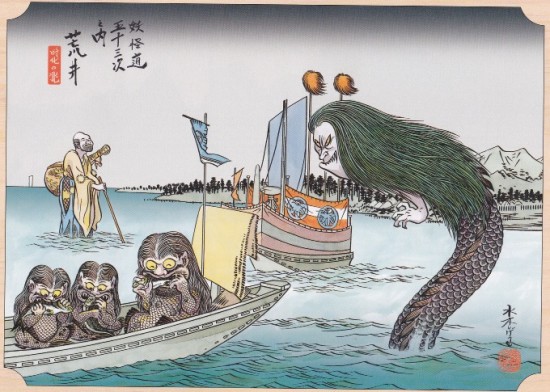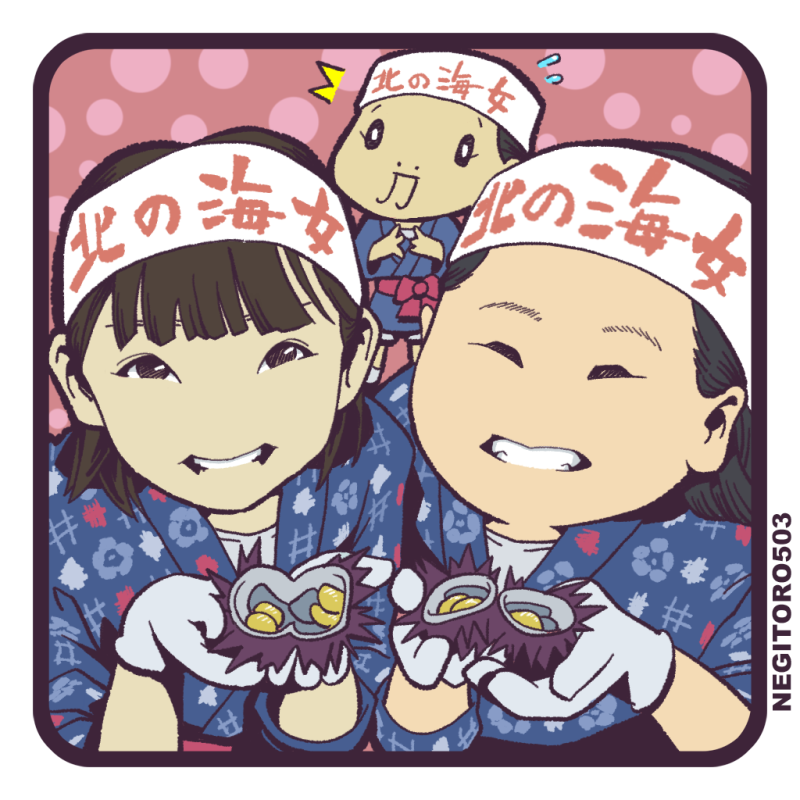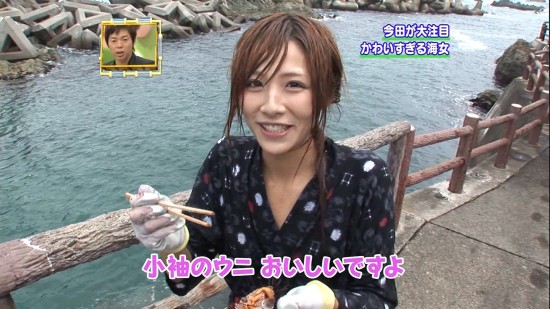Here’s word rich in culture that’s quite unusual and yet very memorable. Ama (海女) means ‘woman of the sea’ and is used to describe the free-diving ladies of Japan’s costal regions who plunge down to the shallows in order to gather shellfish and other food.
What makes this a great word to introduce to beginners is that it combines two of the most basic Kanji to describe something that is immediately understandable, but a little cryptic to those without the background knowledge of Japanese culture. Great, then, for impressing your friends, and perhaps even your Japanese teacher!

海女
あま
Female Diver
The first Kanji in this word is that for ‘sea’ (海). On its own, the word is read as うみ. The second Kanji, 女, means ‘woman’, read as おんな. Put them together and you’ve got ‘sea woman’ or ‘woman of the sea’. Why then is the translation noted as ‘female diver’?
This is a common scenario where you find the literal meaning of feeling of Kanji compounds can seem to differ slightly from the way the word is used in a sentence in modern English. At the same time however, the actual meaning usually does remain true, if a little abstract at times. In this case, although the word Ama does not mention the act of diving at all, these female divers would spend a great deal of time in the ocean searching for clams, abalone and seaweed, as well as occasionally pearls (真珠 – しんじゅ).
Because of this truth, the women could be said to be ‘of the sea’ since they spent so much time working there! This is the beauty of Kanji. Before today I hadn’t memorised this word and its reading, yet I could understand the central concept by looking at the combination of characters. I had some idea that the word referred to women and the sea. The tricky part was then knowing how to interpret this understanding.
For example, ‘woman of the sea’ could easily conjure up images of mermaids, which in Japanese is actually 人魚 (にんぎょ), meaning ‘fish person’. Fish person is very easy to understand even without the culturally appropriate knowledge, but not all words are like this. This is why understanding of the history and culture of a society is so important in the quest to properly grasp its language (and one of the reasons we at Gakuu spend time explaining cultural background in order to properly help readers understand the language used in context).
Once you know that 海女 means ‘female diver’, and that it refers to the ancient practice of women from small, coastal towns diving for shellfish, you will be able to use the word appropriately in context. All that is missing is a few examples sentences to get you on the right track (further below).
Finally, you might wonder why the reading of this word is different from the two words when used in isolation. Generally speaking, when two or more Japanese words are brought together, the original Chinese readings are used to form the new word (although this is not always the case). Those familiar with the Kanji 海 and 女 might recall the common Chinese readings as being かい and じょ respectively (although there are others). So why not read it as かいじょ?
In this example, the word has an even more obscure reading. Although the exact reason is unknown, it’s likely due to the long history and significant role Ama played in Japanese culture that led to the word retaining the obscure reading even in modern Japan. As such, あま is used as the reading of this word.
Equally however, うみおんな, the Japanese reading can also be acceptable in different contexts. Indeed, sometimes using a different reading will invite a different interpretation of the word itself. In this case, saying うみおんな over あま will likely cause people to think of the Japanese sea-woman monster!

Readings therefore are very important to remember, at least to avoid confusion and embarrassment in certain situations!
Here are a few more points to throw you. You can differentiate between different divers by changing the Kanji! All have the same あま reading, but modifying the final character to 士 (し – meaning something male, usually of high class) or 人 (ひと – person), allows you be very specific (or non-specific if needed). In English we need to clumsily say ‘male diver’ or ‘female diver’ in order to do this, which loses some of the elegance.
海士
あま
Male Diver / Fisherman
Note here too that, since the practice of diving for shellfish was largely performed by women, saying 海士 to specify a male would more like be translated as ‘fisherman’.
Or the gender-netural:
海人
あま
Diver / Fisherman
Note here that ‘diver’ does not refer to modern day scuba divers, which would use the Katakana word ダイバー. Also note that while the Japanese word is gender-neutral, the English translation is not as we don’t have a word in common use to describe the situation.
Finally then, below are a few examples of the word in context. Most of the sentences are too hard for beginners, so don’t worry if you have trouble with them!
大注目のかわいすぎる海女
だいちゅうもくの かわいすぎる あま
The really cute Ama girl who is the center of attention
**********
アメ横に期間限定あまちゃんの海女カフェができました。
アメよこに きかんげんてい あまちゃんの あまカフェが できました。
An Ama-chan cafe has opened in Ameyoko-cho for a limited time.
**********
かつて、海女は真珠の養殖にとってなくてはならない存在でした。
かつて、あまは しんじゅの ようしょくにとって なくてはならなない そんざい でした。
At one point in time, Ama were essential for the cultivation of pearls.
**********
海女さんの職業についたら夏場だけでなく、冬場の寒い季節でも年中、海に潜らなければなりません。
あまさんの しょくぎょうに ついたら なつばだけでなく、 ふゆばの さむいきせつでも ねんじゅう、 うみに くぐらなければなりません。
If you become an Ama, you must work all year round, not just in the summer but also in the cold winter season.
If you’re interested in reading more about the Ama, I wrote a short article on the history and culture on Gakuran.com: The Pearl Diving Mermaids of Japan. Be warned though, that traditional practices saw Ama diving almost naked, so if you’re shy, it might be best not to click the link. (It’s all tasteful nudity though!)


Leave a Reply